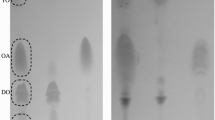Abstract
2,5-Dialkylthiophenes are found in bitumens and crude oils, and previous studies showed that bacterial metabolism of some with a methyl substituent lead to the formation of 5-methyl-2-thiophenecarboxylic acid, which persisted in the culture medium (Fedorak PM & Peakman TM 1992 Biodegradation 2: 223–236). The objectives of this investigation were to study the further metabolism of this acid, and of two dialkylthiophenes, 2,5-diundecylthiophene and 2-(3,7-dimethyloctyl)-5-methylthiophene. Undefined, oil-degrading mixed cultures were used. 5-Methyl-2-thiophenecarboxylic acid was oxidized to 2,5-thiophenedicarboxylic acid which was identified by gas chromatography-mass spectrometry (GC-MS). This dicarboxylic acid was degraded and supported the growth of a mixed microbial population, and approximately 50% of the sulfur in this substrate was detected as sulfate in the medium at the end of the 15-day incubation time. Mixed cultures were incubated with 2,5-diundecylthiophene or 2-(3,7-dimethyloctyl)-5-methylthiophene as their sole carbon source, and at various times some of these were freezedried and the residues were treated to form methyl esters of any carboxylic acids produced. GC-MS analyses showed the presence of several dicarboxylic acids, indicating that both alkyl groups were oxidized. A small amount of the dimethyl ester of 2,5-thiophenedicarboxylic acid was detected in the culture grown on 2,5-diundecylthiophene, and 37% of the sulfur from this dialkylthiophene was detected as sulfate in the medium after 35 days of incubation.
Similar content being viewed by others
References
Abdulrashid N & Clark DP (1987) Isolation and genetic analysis of mutations allowing the degradation of furans and thiophenes by Escherichia coli. J. Bacteriol. 169: 1267–1271
Andersson JT & Bobinger S (1992) Polycyclic aromatic sulfur heterocycles. II. Photochemical oxidation of benzo[b]thiphene in aqueous solution. Chemosphere. 24: 383–388
APHA (1989) Standard Methods for the Examination of Water and Wastewater, 17th Edition. American Public Health Association, Washington, DC
Atlas RM & Bartha R (1992) Microbial Ecology: Fundamentals and Applications, 3rd Edition. Benjamin/Cummings Publishing Company, Inc. Redwood City, CA
Cripps RE (1973) The microbial metabolism of thiphen-2- carboxylate. Biochem. J. 134: 353–366
Evans JS & Venables WA (1990) Degradation of thiphene-2- carboxylate, furan-2-carboxylate, pyrrole-2-carboxylate and other thiophene derivatives by the bacterium Vibrio YC1. Appl. Microbiol. Biotechnol. 32: 715–720
Fedorak PM & Grbić-Galić D (1991) Aerobic microbial cometabolism of benzothiophene and 3- methylbenzothiophene. Appl. Environ. Microbiol. 57: 932–940
Fedorak PM & Peakman TM (1992) Aerobic microbial degradation of some alkylthiphenes found in petroleum. Biodegradation. 2: 223–236
Fedorak PM & Westlake DWS (1983) Selective degradation of biphenyl and methylbiphenyls in crude oil by two strains of marine bacteria. Can. J. Microbiol. 29: 497–503
Fedorak PM & Westlake DWS (1984) Degradation of sulfur heterocycles in Prudhoe Bay crude oil by soil enrichments Water, Air Soil Pollut. 21: 225–230
Fedorak PM & Westlake DWS (1986) Fungal metabolism of n-alkylbenzenes. Appl. Environ. Microbiol. 51: 435–437
Foght JM, Fedorak PM & Westlake DWS (1990) Mineralization of 14C-hexadecane and 14C-phenanthrene in crude oil: Specificity among bacterial isolates. Can. J. Microbiol. 36: 169–175
Hutton D & Steinberg D (1973) Identification of propionate as a degradation product of phytanic acid oxidation in rat and human tissue J. Biol. Chem. 248: 6871–6875
Kanagawa T & Kelly DP (1987) Degradation of substituted thiophenes by bacteria isolated from activated sludge. Microb. Ecol. 13: 47–57
Krawiec S (1990) Bacterial desulfurization of thiophenes: screening techniques and some speculations regarding the biochemical and genetic basis. Dev. Ind. Microbiol. 31: 103–114
Mahler HR & Cordes EH (1966) Biological Chemistry. Harper and Row, New York, NY
Monticello DJ (1993) Biocatalytic desulfurization of petroleum and middle distillates. Environ. Prog. 12: 1–4
Omori T, Monna L, Saiki Y & Kodama T (1992) Desulfurization of dibenzothiophene by Corynebacterium sp. strain SY1. Appl. Environ. Microbiol. 58: 911–915
Peakman TM & Kock-van Dalen AC (1990) Identification of alkylthiophenes occurring in the geosphere by synthesis of authentic standards. In: Orr WL & White CM (Eds.) Geochemistry of Sulfur in Fossil Fuels (pp 397–416). ACS Books, Washington, DC
Pirnik MP, Atlas RM & Bartha R (1974) Hydrocarbon metabolism by Brevibacterium erythrogenes: Normal and branched alkanes. J. Bacteriol. 119: 868–878
Sinninghe Damsté JS, ten Haven HL, de Leeuw JW & Schenck PA (1986) Organic geochemical studies of a Messinian evaporitic basin, northern Apennines (Italy). II. Isoprenoid and n- alkyl thiophenes and thiolanes. Org. Geochem. 10: 791–805
Sinninghe Damsté JS, de Leeuw JW, Kock-van Dalen AC, de Zeeuw MA, de Lange F, Rijpstra WIC & Schenck PA (1987) The occurrence and identification of series of organic sulphur compounds in oils and sediments. I. A study of Rozel Point oil (U.S.A.) Geochim. Cosmochim. Acta 51: 2369–2391
Sinninghe Damsté JS & de Leeuw JW (1989) Analysis, structure and geochemical significance of organically-bound sulphur in the geosphere: State of the art and future research. Org. Geochem. 16: 1077–1101.
Sinninghe Damsté JS, Rijpstra WIC, de Leeuw JW & Schenck PA (1989) The occurrence and identification of series of organic sulphur compounds in oils and sediment extracts. II. Their presence in the samples from hypersaline and non-hypersaline depositional environments and possible application as source, maturity and palaeoenvironmental indicators. Geochim. Cosmochim. Acta. 53: 1323–1341
Tanaka H, Maeda H, Suzuki H, Kamibayashi A & Tonomura K (1982) Metabolism of thiophene-2-carboxylate by a photosynthetic bacterium. Agric. Biol. Chem. 46: 1429–1438
van Afferden M, Schacht S, Klein J & Trüper HG (1990) Degradation of dibenzothiophene by Brevibacterium sp. DO. Arch Microbiol. 153: 324–328
Author information
Authors and Affiliations
Rights and permissions
About this article
Cite this article
Fedorak, P.M., Coy, D.L. & Peakman, T.M. Microbial metabolism of some 2,5-substituted thiophenes. Biodegradation 7, 313–327 (1996). https://doi.org/10.1007/BF00115745
Issue Date:
DOI: https://doi.org/10.1007/BF00115745




